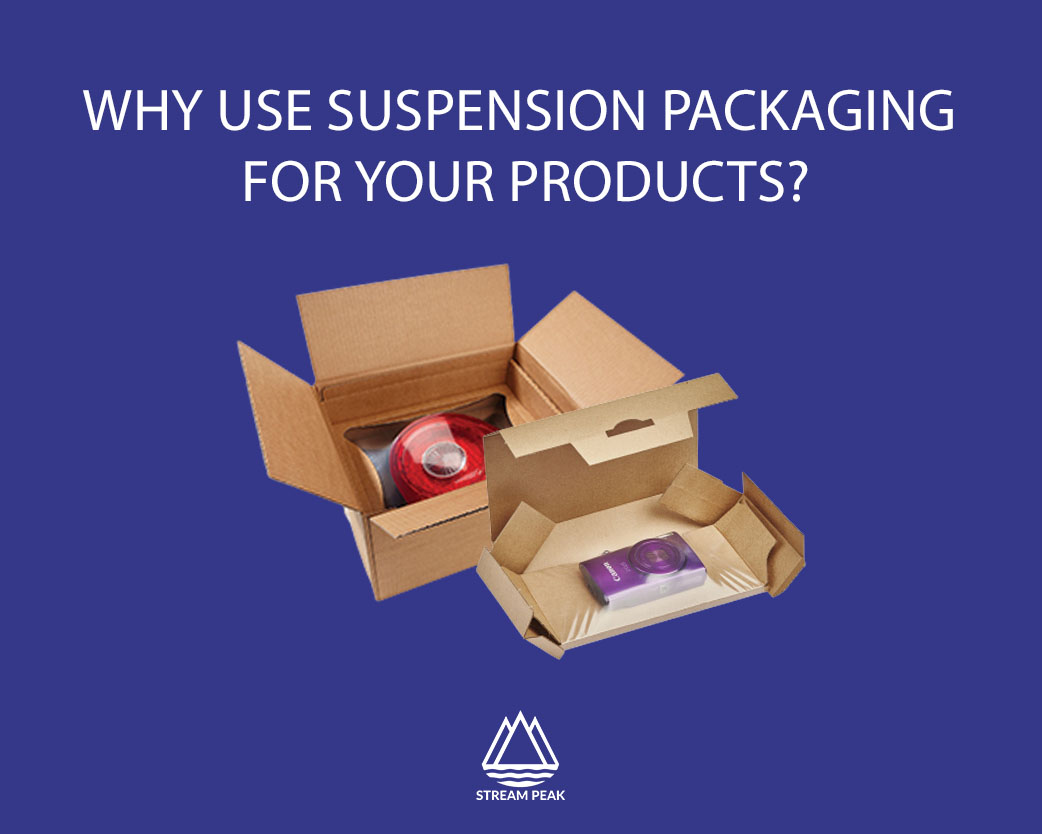
Why use Suspension Packaging for your Products
Corrugated cardboard boxes are commonly used for packaging and protecting goods. Void fillers are placed around the corrugated box to prevent or limit movement during transportation. Common void fillers include air pillows, polystyrene flakes, crumpled paper, and cardboard folded into a hollow form.
Commonly used void fillers have several disadvantages, such as:
- Many void fillers (such as polystyrene flakes or air pillows) are not considered environmentally friendly.
- Crumpled paper is not a suitable void filler for absorbing repeated impacts.
- The void fillers must cushion all sides of the product. However, the void fillers may shift during transport. Hence, at the final delivery stage to the end customer, not all sides might be well protected.
- These void fillers are challenging to automate.
Therefore, suspension packaging is gaining popularity as a next-generation packaging solution.
What is Suspension Packaging?
Suspension packaging is a three-part system that suspends an item in the centre of a carton by sandwiching it between two layers of polythene film. The two layers of film act similarly to the suspension on a car, ironing out the impacts the parcel encounters during a transit period. The packages are also simple to assemble and fill without the use of any additional adhesive.
How Does Suspension Packaging Work?
Suspension packaging uses special corrugated inserts and flexible plastic film. The corrugated inserts are designed to fit into the shipment box and work with the film to keep the product suspended. This is done to position it more centrally within the outer packaging unit. It prevents the item from moving inside the box and keeps it away from significant impact points during delivery.
Suspension Packaging Features
- Static Barrier protection
- Wide range of sizes
- Crush resistance
- Variable Stretch options
- Impact resistance
- Corrosion inhibitor protection
- Attractive product display
Suspension Packaging Benefits
INNOVATIVE: The design is a unique package assembly consisting of a solid and flexible PE film and corrugated paperboard.
PROTECTIVE: It protects mailed products from physical danger and damage. Packages are susceptible to damage during transportation due to rough handling and vehicle movement.
ATTRACTIVE: It displays the product to the end-user functionally and attractively. This improves the unboxing experience for customers.
VERSATILE: It can accommodate various product sizes, weights, and forms, reducing the number of packaging necessary for each product.
ECONOMICAL: The sustainable packaging assembly is supplied flat. Hence they will take up less storage, allowing the storage of other materials.
SUSTAINABILITY: It contributes to a reduction in the overall use of materials commonly used in the protective packaging industry, such as packing peanuts, bubble wrap, foam packaging, packing paper and more. As a result, fewer materials will end up in landfills, reducing the overall carbon footprint.
Suspension packaging Applications
Electronics—Suspension packaging uses robust and flexible film, secures electronics during transportation, absorbs shock and provides excellent visibility for the product.
Plates—Suspension packaging uses a robust and flexible film that holds the plates firmly during shipping and absorbs shock. The springy effect of the suspension packaging helps to soften even more impact, thus protecting the fragile plates.
Wine bottles—Suspension Packaging allows the brand to be highlighted with slick packaging while providing the best protection.
Heavy and fragile objects—The packaging frame provides extra cushioning on the bottom for weighty and fragile objects. The flexible retention film also accommodates a wide range of products and accessories. It is ideal for new or refurbished products due to its visibility.
How to assemble Suspension Packaging
At the packaging station, the frame is assembled and placed in the box to suspend the product in the center of the container. The window above is placed over the product, completely suspending the item between two solid and flexible, low-slip films. The box is closed, creating tension that holds the product securely between the two suspension windows, protecting it from shock.
Retention Packaging
Retention packaging is a type of suspension packaging that uses a thin film to keep or retain the packaged item on a piece of a corrugated board. The space around the product creates a protective zone for the product. The best part of retention packaging is how it is presented to users when they open the packaging, as the transparent film gives customers an excellent open concept.
How to assemble Retention Packaging
Firstly the side flaps are folded upward, forming an “insertion pocket” for easy product loading while loosening the film.
The side flaps are folded down and under to tighten the retention film and securely hold the product. The end flaps fold up.
The finished package can now be easily inserted into the carton and is ready for shipment.
Suspension vs Retention Packaging
Suspension packaging often provides impact resistance, while retention packaging secures the product and prevents it from shifting. Suspension packaging is a three-part method similar to the retention packaging solution. The difference is that the item packed by suspension packaging is sandwiched between two layers of polythene film and suspended. In contrast, the product being sealed by retention packaging is sandwiched between a film and a corrugated board. Suspension packaging is also often used for more extensive and delicate products, giving a softer cushioning effect.
Usability of Suspension and Retention Packaging
The packaging film will conform to various product shapes and sizes, making the packs versatile and accommodating multiple items. This helps keep your packaging inventory manageable, plus benefits from economies of scale when ordering. The system is also supplied flat to save on storage and is exceptionally easy to assemble. This allows for efficient packaging and fast shipments.
In conclusion, these assemblies are scalable and customisable, making suspension or retention packaging an ideal solution to protect a wide range of products. The key benefit of this protection is that, unlike some packaging inserts such as polystyrene or certain foams, the protection levels are not compromised even after multiple drops or mishandling.

